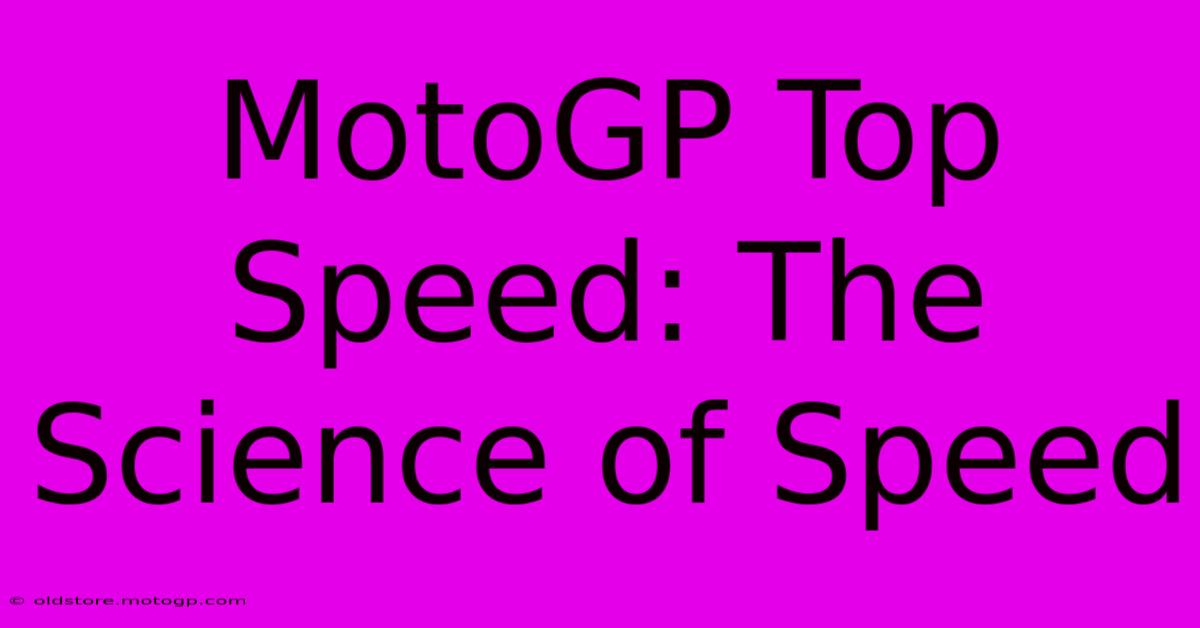MotoGP Top Speed: The Science Of Speed

Table of Contents
MotoGP Top Speed: The Science of Speed
MotoGP. The pinnacle of motorcycle racing. The roar of the engines, the breathtaking speeds, the nail-biting overtakes – it's a spectacle that captivates millions. But beyond the drama and excitement lies a fascinating world of engineering and physics, all geared towards achieving the ultimate goal: top speed. This article delves into the science behind those incredible speeds, exploring the factors that contribute to a MotoGP bike's velocity.
Understanding MotoGP Top Speed
MotoGP bikes are not just fast; they're incredibly fast. Top speeds regularly exceed 200 mph (320 km/h) on certain tracks, particularly long straights. Achieving these speeds is a complex interplay of several key elements:
1. Engine Power and Torque: The Heart of the Beast
The heart of any MotoGP bike is its engine. These highly-tuned prototypes boast immense power and torque, figures far exceeding those of even the most powerful production motorcycles. Massive horsepower is crucial for acceleration and maintaining high speeds, especially when overcoming aerodynamic drag. The engine's power delivery, carefully calibrated through sophisticated engine mapping, also plays a crucial role.
2. Aerodynamics: Cutting Through the Air
Aerodynamics plays a critical role in MotoGP top speed. At these high velocities, air resistance (drag) becomes a significant force, dramatically affecting the bike's ability to accelerate and maintain speed. Sophisticated aerodynamic packages, including winglets, fairings, and streamlined bodywork, are designed to minimize drag and enhance downforce (the force pushing the bike down onto the track, improving stability at high speeds). The meticulous design of these elements is a testament to the power of computational fluid dynamics (CFD) in modern motorsport.
3. Chassis and Suspension: Maintaining Stability
Even with immense power and aerodynamic efficiency, maintaining stability at these incredible speeds is paramount. The chassis, suspension, and tire design all contribute significantly. A rigid chassis, capable of withstanding enormous stress, ensures precise handling and prevents unwanted flex at high speeds. Sophisticated suspension systems help absorb bumps and maintain optimal tire contact with the track, crucial for traction and control.
4. Tires: The Grip Factor
The tires are the only point of contact between the bike and the track, making them absolutely crucial for achieving and maintaining high speeds. High-performance racing tires, specifically designed for MotoGP, provide exceptional grip even at the extreme forces experienced at top speed. The tire compound, construction, and profile all play a role in optimizing traction and minimizing slip, maximizing acceleration and stability.
5. Rider Skill: The Human Element
While technology plays a dominant role, the rider's skill is an often-underestimated factor. A skilled MotoGP rider's ability to maintain perfect body position, minimize drag, and precisely control the machine at these high speeds can be the difference between achieving top speed and losing precious tenths of a second. Rider input is crucial in maximizing performance from the entire system.
Factors Affecting Top Speed Variation
Several factors contribute to variations in top speed between races and even within the same race:
- Track characteristics: Long straights naturally lead to higher top speeds, while tighter corners necessitate braking and reduced speed.
- Weather conditions: Wind, temperature, and track surface condition significantly impact aerodynamic drag and tire grip.
- Bike setup: Minor adjustments to suspension, aerodynamics, and engine mapping can noticeably affect top speed.
- Fuel load: A lighter fuel load allows for higher acceleration and top speeds.
The Future of MotoGP Top Speed
Ongoing technological advancements continue to push the boundaries of MotoGP top speeds. Further refinements in aerodynamics, engine technology, and tire design are likely to lead to even faster lap times and higher top speeds in the future. The pursuit of speed in MotoGP is a constant evolution, an engaging interplay of cutting-edge engineering and human skill. The next generation of bikes is poised to break records we only dream of today.
Keywords: MotoGP, Top Speed, Motorcycle Racing, Aerodynamics, Engine Power, Torque, Chassis, Suspension, Tires, Rider Skill, Track Characteristics, Weather Conditions, Technology, Engineering, Physics, Speed Records, MotoGP Bikes, High Speed, Racing Technology.

Thank you for visiting our website wich cover about MotoGP Top Speed: The Science Of Speed. We hope the information provided has been useful to you. Feel free to contact us if you have any questions or need further assistance. See you next time and dont miss to bookmark.
Featured Posts
-
Moto Gp Starting Grid Witness The Birth Of A Champion
Feb 18, 2025
-
Sprint Racing Revolutionizes Moto Gp
Feb 18, 2025
-
Cota Parking Secrets Revealed The Map
Feb 18, 2025
-
F1 Austin Embrace The Electric Atmosphere
Feb 18, 2025
-
The Best Motorcyclist Of All Time An Unforgettable Icon
Feb 18, 2025
